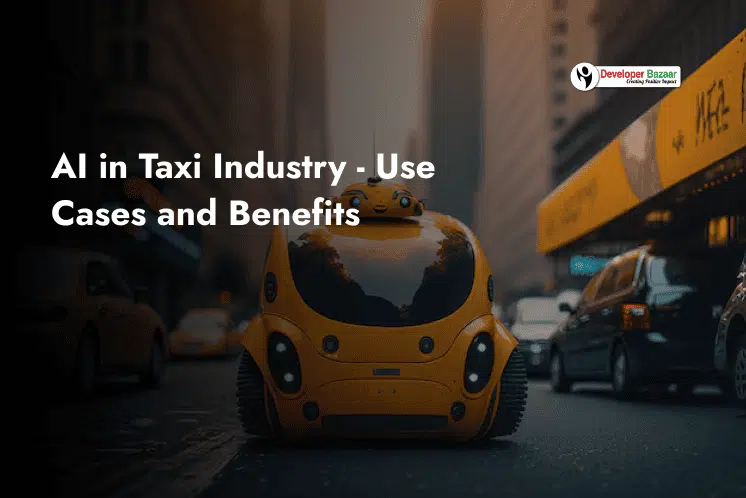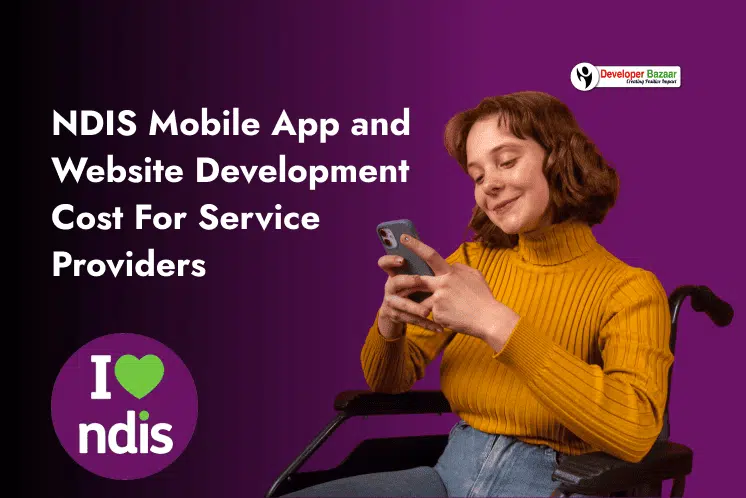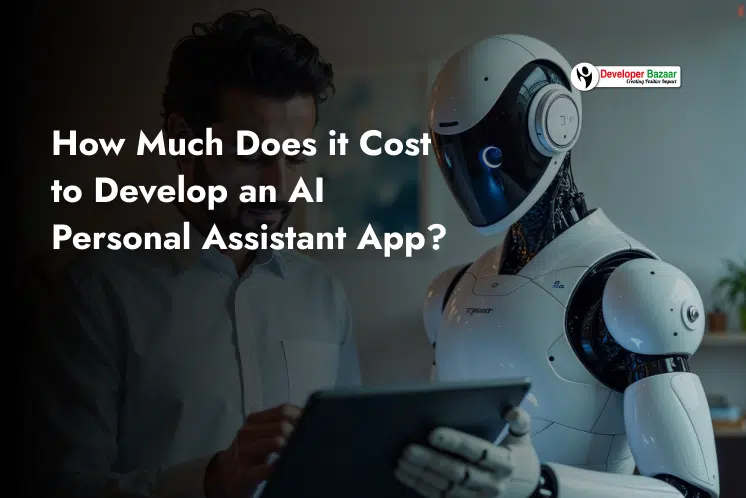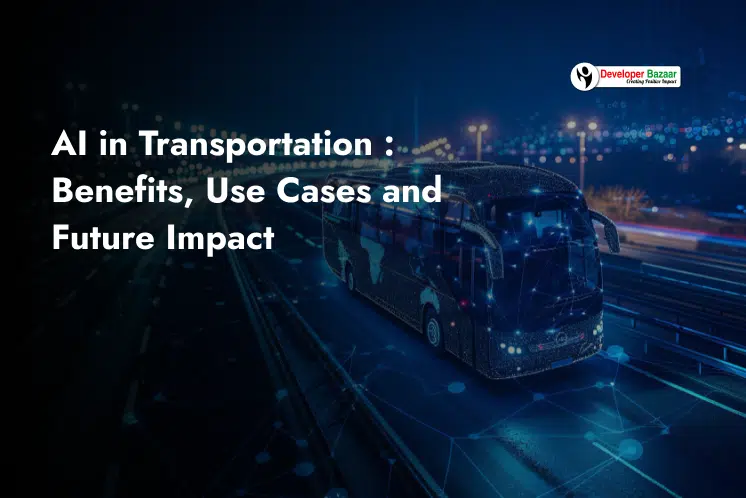Table of Contents
ToggleThe taxi world is changing fast. First came ride-sharing apps. Now, AI in the taxi industry is rising and reaching to the next level. Today’s taxi apps do more than book rides. They think, learn, and improve with time.
This guide talks about how AI-powered taxi app development is making travel better for riders and drivers. You’ll learn how AI helps apps work smarter, what makes them different from old systems, and why now is the best time to build one.
Market Analysis of AI in Transportation Sector
The transport world is going digital. Artificial Intelligence (AI) is now a big part of this change. AI is helping taxi services grow faster and become more user-friendly.
According to Business of Apps, the taxi app market will reach $283 billion by 2028, growing steadily at 4.2% each year. That’s a strong reason for businesses to enter the market.
Also, more people are using smartphones, especially in developing countries. This makes it easier for taxi apps to reach more users. So, if you want to develop a ride sharing mobile app, now is a right time to start.
What Is AI-Powered Taxi App Development?
AI-powered taxi app development means building apps that can think and act smart. These apps use AI to:
- Find the best routes
- Match drivers and riders
- Set fair prices
- Stop fraud
- Help customers faster
Before, taxi apps were basic. Now, with AI in taxi industry, apps are faster, safer, and more fun to use. AI can also predict traffic, plan ahead, and make better choices. That’s why many people now choose AI app development company that use AI.
The Role of AI in Modern Taxi Development Services
AI is like a smart assistance inside your taxi app. It makes everything smoother. Below are the reason why:
- Faster booking: AI finds the best driver nearby.
- Smarter pricing: It changes prices based on traffic, time, or weather.
- Better travel: AI checks live traffic and picks the shortest route.
- Personal service: It remembers what users like.
- Safe rides: AI can stop fraud and spot strange activity early.
With all this, AI-powered taxi apps offer better speed, fewer mistakes, and happier users. That’s why many companies hire a mobile app development company to build smarter taxi apps today.
How Traditional vs AI-Powered Taxi Systems is Different?
AI is bringing huge changes in how taxi systems work today. While traditional taxi systems still rely on basic tools and manual work, AI-powered taxi apps use smart technology to make every step faster, safer, and more accurate. Let’s explore the key differences between the two:
1. Dispatch Process
In traditional taxi systems, dispatching is usually done manually or with basic software.
But with AI in taxi industry, the app automatically finds the closest available driver, checks the route conditions, and assigns them instantly. This reduces waiting time and ensures quicker pickups for passengers.
2. Pricing Strategy
Conventional taxi fares are mostly fixed or only slightly adjusted depending on the city or time of day. This system doesn’t respond well to changes like sudden traffic, high demand, or special events. As a result, either the rider pays too much or the company loses money.
On the other hand, AI-powered pricing is dynamic. It uses real-time data like demand levels, local traffic, weather, and events to adjust fares fairly. This helps both passengers and service providers stay satisfied and competitive.
3. Route Optimization
Traditional taxi systems rely heavily on simple GPS tools for navigation. These systems can guide drivers but don’t always offer the fastest or most efficient routes, especially during heavy traffic or roadblocks.
In contrast, AI-based taxi apps learn from past trip data, current road conditions, and predictive traffic patterns. They suggest the shortest and fastest routes automatically, saving time and fuel. This not only improves the rider’s experience but also helps reduce operational costs.
4. Security & Fraud Detection
Manual checks in traditional systems make it difficult to find fraud or suspicious activity quickly. For example, fake ride bookings or route manipulation might go unnoticed for a long time.
AI-powered taxi systems are much better at handling this. They monitor rides in real-time, flag unusual patterns, and alert operators instantly if something seems off. AI can detect fraud early, helping protect both riders and drivers.
5. Driver-Rider Matching
Standard taxi services usually match passengers with drivers based only on location or simple order queues. This can lead to mismatches in terms of language, preferences, or service quality.
With AI integration in taxi app development, the system looks deeper. It checks the rider’s preferences, past booking history, behavior, and ratings to find the best possible driver match. This improves satisfaction, makes the ride more comfortable, and builds customer trust.
Basically, traditional systems are slower and less flexible, while AI-powered taxi app development makes everything faster, smarter, and more reliable.
Some Major Use Cases Of AI in the Taxi App
AI in taxi industry is changing the way ride-sharing apps work. It helps make smarter decisions, faster rides, and happier customers.
Below are some major use cases:
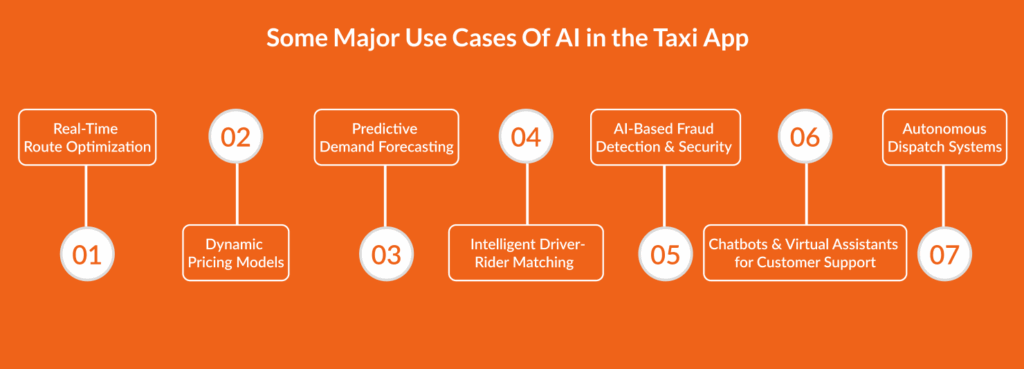
1. Real-Time Route Optimization
AI finds the best and fastest route. It checks traffic, weather, and past trip data. This saves fuel, time, and helps drivers avoid roadblocks or construction. Riders reach faster and drivers waste less time.
2. Dynamic Pricing Models
AI changes ride prices based on demand, weather, traffic, or events. During rush hours, it sets higher prices to attract more drivers. This way, riders get rides quicker and drivers earn more. It keeps the system fair for everyone.
3. Predictive Demand Forecasting
AI predicts when and where people will need rides. It looks at bookings, weather, and local events. This helps drivers go to busy spots ahead of time. Riders wait less, and drivers earn more.
4. Intelligent Driver-Rider Matching
AI matches the right driver with the right rider. It checks location, driver rating, language, and past rides. Riders feel more comfortable, and fewer rides get canceled.
5. AI-Based Fraud Detection & Security
AI can find fake accounts, double bookings, and wrong payments. It keeps the taxi app safe and secure. It protects users and the company.
6. Chatbots & Virtual Assistants for Customer Support
AI chatbots help riders book a cab or ask questions 24/7. They give fast answers and solve problems without needing a human. It saves money and improves service quality.
7. Autonomous Dispatch Systems
AI assigns rides automatically. It looks at vehicle availability, rider’s location, and traffic. No need for a dispatcher. Trips are assigned fast, and drivers stay productive.
Key Benefits of AI Integration in Taxi App Development
AI brings many advantages to taxi app development. There are many key benefits of AI integration:
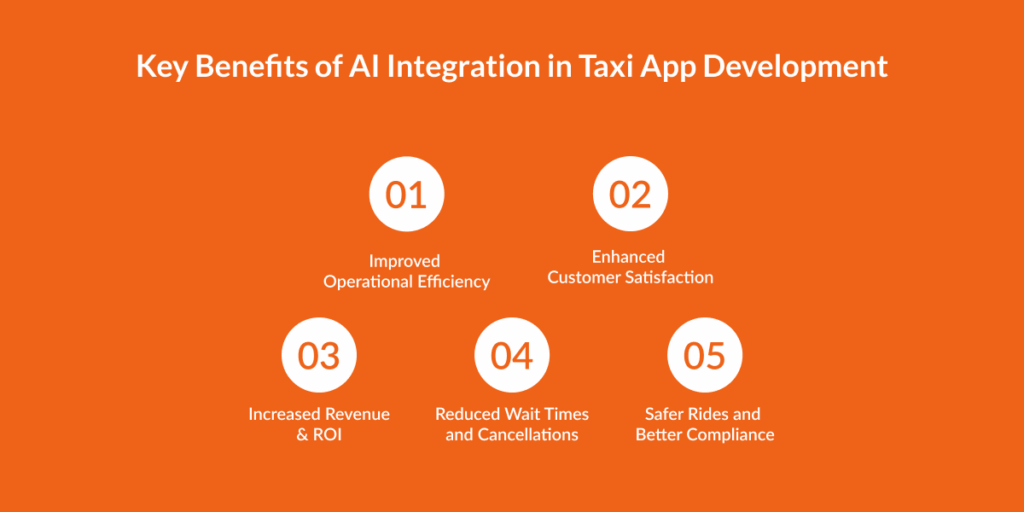
1. Improved Operational Efficiency
AI automates dispatching, routing, and pricing. It reduces human errors and workload. Mobile app development companies use AI to manage fleets and drivers better.
2. Enhanced Customer Satisfaction
AI gives real-time ride updates. It helps match riders with the best drivers. Chatbots solve rider problems quickly. This leads to better ratings and more loyal users.
3. Increased Revenue & ROI
AI boosts profits. It adjusts prices smartly, reduces idle time, and improves matching. Businesses earn more per ride. Using AI gives a higher return on investment.
4. Reduced Wait Times and Cancellations
AI predicts demand and routes drivers quickly. Riders wait less and get fewer canceled rides. Drivers stay busy, and users stay happy.
5. Safer Rides and Better Compliance
AI watches for unsafe driving or fake accounts. It warns drivers and flags issues. It also helps companies follow safety rules and protect rider data.
Real-World Case Studies Showcasing AI in Taxi Apps
Several top companies use AI in taxi industry and boost their business:
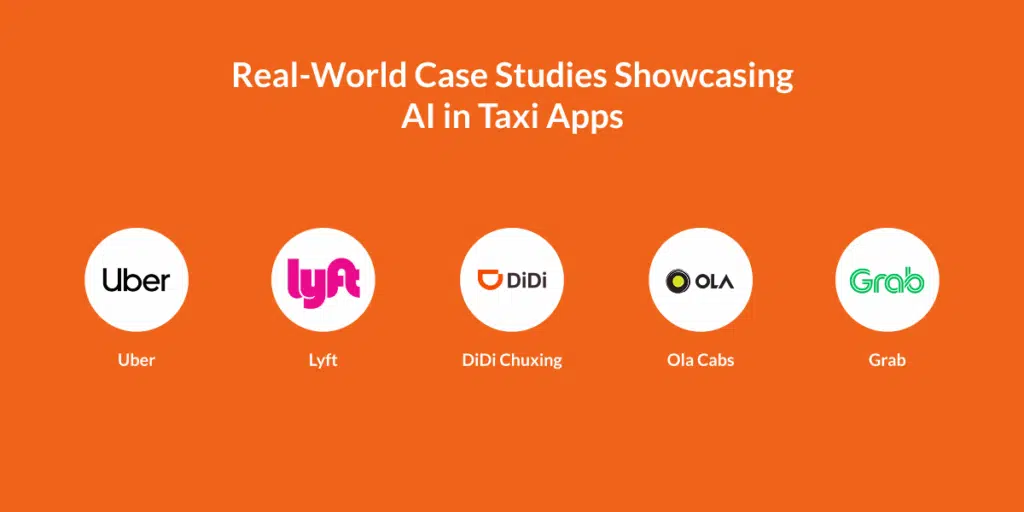
1. Uber
Uber uses AI for route planning, price updates, and smart matching. It checks huge amounts of data daily. This gives better ETAs, avoids fraud, and improves rider satisfaction.
2. Lyft
Lyft uses AI to keep riders and drivers safe. It spots distracted driving using phone sensors. AI also helps drivers move to busy areas, so they get more trips.
3. DiDi Chuxing
DiDi uses over 100 data points to match riders and drivers in under a second. It predicts demand with 91% accuracy. This helps reduce waiting times and keeps rides on time.
4. Ola Cabs
Ola uses AI to set prices and give driver rewards. It also guesses where riders will go next. This helps reduce downtime and boosts the use of each car.
5. Grab
Grab uses AI for fraud detection, tracking, and route planning. It spots and stops fraud early. Its smart tech also helps drivers use less fuel and improve their driving.
Develop a Taxi App with AI Integration?
Building a smart, AI-powered taxi app needs planning, the right features, and the right team.
1. User Interfaces
A taxi app must be simple to use for both passengers and drivers.
- For riders: The app should have clear options to book a cab, check the fare, track the driver in real time, and pay easily.
- For drivers: The app should let them accept rides with one tap, see the pickup location, and use maps to reach the destination smoothly.
2. Core Functionality
These are the basic tools your taxi app must have to work properly:
- Ride booking: Riders must be able to book a ride with just a few taps.
- Payment system: Support multiple payment options—UPI, cards, wallets, and cash.
- Live location tracking: Let riders see where their cab is and how long it will take to arrive.
- Ratings and reviews: Riders and drivers can rate each other. This helps improve service quality and build trust.
3. AI Components
AI is what makes your app smart and efficient.
- Driver-rider matching: AI looks at the location, ratings, and history to connect the best rider with the best driver.
- Demand prediction: AI studies ride history and events to know when and where the demand will rise. This way, drivers can go to busy areas in advance and get more rides.
- Dynamic pricing: AI adjusts fares during busy hours or bad weather, helping drivers earn more and keeping supply balanced.
These smart tools improve speed, safety, and satisfaction.
4. Admin Systems
This is the control room of your app, where everything is managed.
- User management: Add, remove, or update rider and driver profiles.
- Trip data: View bookings, trips, cancellations, and payments.
- Reports and dashboards: See useful charts and data to track growth, earnings, and user activity.
- Dispute handling: Resolve any rider or driver complaints quickly.
Admin tools help you run the app smoothly and make smart business decisions.
5. Support Mechanisms
Great support builds trust and loyalty among users.
- AI chatbots: Handle simple questions like fare details, booking steps, or cancellation rules instantly.
- Live support: For complex issues, let users talk to real human agents through chat or call.
Quick and helpful support makes users feel valued and keeps them using your app.
Development Roadmap
This is the complete journey of building your AI-powered taxi app from the first idea to the final launch and beyond. Let’s walk through each step in detail:
1. Discovery Phase
First, study the market to understand the current trends and competition. Learn what your users really need, what problems they face and what features they would love. Set clear goals for your app, like improving ride quality or cutting down waiting time. It’s also important to check local laws and safety rules around ride-sharing, as every city or country may have different regulations.
2. Design and Planning
Once you understand your users, it’s time to plan the look and feel of your app. Start by sketching wireframes, basic drawings that show where buttons and features will appear. Then, choose the technology tools you’ll use, such as Android, iOS, or a backend platform like Node.js. After that, make a full list of features your app should have—for passengers, for drivers, and for admins who will manage the system.
3. MVP Development (Minimum Viable Product)
Build a simple first version of your app with only the core features like booking a ride, making a payment, and tracking the cab in real time. This is called the MVP. Launch it quickly so you can test it with a small group of users. Their feedback will help you understand what’s working and what needs fixing.
4. AI Integration
Once the base app is ready, you can start adding smart features powered by AI. Begin with simple tools like matching riders with nearby drivers or suggesting the best routes. As your app grows, you can add more advanced AI features such as dynamic pricing, fraud detection, predictive demand forecasting, and AI chatbots. These tools will make your app faster, safer, and smarter over time.
5. Testing and Refinement
Before launching your app to everyone, test it thoroughly. Make sure every feature works correctly. Fix any bugs or errors you find. Also, check how the app performs when many users are using it at the same time. Don’t forget about security—make sure user data is protected and safe from hackers. Regular testing keeps your app reliable.
6. Launch and Growth
Finally, you’re ready to go live! Start small by launching your app in just one city or area. Watch how users are interacting with the app, track their feedback, and fix any early issues.
Once the app runs smoothly, you can slowly expand to more cities. Keep improving the app regularly by adding new features, fixing bugs, and upgrading the AI systems.
How to Overcome Challenges in Implementing AI in the Taxi Sector?
AI in the taxi industry brings smart features and better service, but it’s not always easy to use. Businesses face some real challenges when they want to develop an AI-driven taxi app.
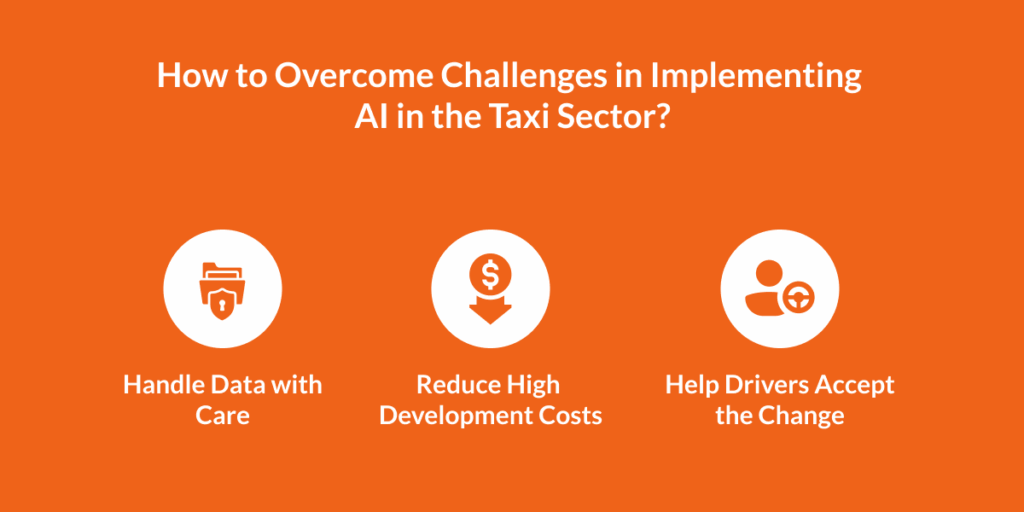
1. Handle Data with Care
AI needs a lot of user data like locations, payment habits, and travel history. This helps the system work better, but it also creates privacy concerns.
To keep user trust, taxi companies must follow global data privacy laws, use encryption, and avoid misusing customer information. Doing so keeps the app secure and customers loyal.
2. Reduce High Development Costs
Developing AI features is not cheap. It involves hiring experts, setting up cloud systems, and training AI models. This makes the mobile application development cost quite high, especially for small companies.
A smart way to manage this is to start small. Use basic AI features first and add more as the app grows. Partnering with a good mobile app development company can also help save time and money.
3. Help Drivers Accept the Change
AI may improve routes and match drivers faster, but not everyone is ready for it. Some drivers worry about job loss or being watched too closely. This is why taxi companies must explain the benefits clearly and provide easy training. When drivers feel supported, they are more likely to accept the new tools.
By solving these problems early, businesses can smoothly develop ride sharing mobile apps with powerful AI features that actually work for both users and drivers.
How Much Cost to Develop Taxi App with AI Features?
The mobile application development cost depends on how smart and advanced you want your taxi app to be.
1. Basic AI Integration
For basic AI integration costs $20,000 – $40,000. This budget covers features like chatbot support, smart route suggestions, and basic rider-driver matching. It’s perfect for startups who want to use AI in taxi industry without spending too much.
Using cross-platform tools like React Native also helps build apps for Android and iOS at the same time.
2. Advanced Features
For including advanced features, it will cost $40,000 – $75,000. This range includes dynamic pricing, demand prediction, and fraud detection.
It requires custom AI models, stronger backend systems, and more data processing. Businesses that want their app to be smarter and offer real-time insights should go for this level.
3. Fully AI-Driven Platform
To build a fully AI-based platform, it will take $75,000 – $150,000 is a complete package to develop an AI-driven taxi app. It includes features like real-time driver analytics, full fleet management, AI-powered dashboards, and user-friendly designs.
No matter your budget, working with professional taxi booking app development services can help you build the right product and make it easier to scale in the future.
Future Trends of AI in Taxi Industry
AI in the taxi industry is growing fast. Many exciting trends are changing how we book, ride, and manage taxis. Here are the future trends to watch:
1. Self-Driving Taxis
Big companies like Tesla and Waymo are testing autonomous taxis. These cars use sensors, cameras, and AI to drive without a human. In the future, this can lower costs, reduce accidents, and make ride-hailing fully automated.
2. AI + IoT for Smart Cars
When AI works with IoT (Internet of Things), vehicles get even smarter. Cars can now send live updates about their health, traffic conditions, and how the driver behaves. This helps taxi app development teams build apps that improve safety and make fleets run better.
3. Predictive Maintenance
AI can tell when a vehicle might break down before it happens. This is called predictive maintenance. It helps taxi companies fix cars early, avoid delays, and save money on big repairs. It also makes sure passengers don’t face last-minute cancellations or poor service.
In short, AI is not just a trend it’s the future. Businesses that adopt it today will stay ahead tomorrow.
Conclusion
AI is helping the taxi industry get faster, smarter, and more reliable. Whether it’s matching the right driver, planning the best route, or adjusting the fare, AI makes everything smoother. With the help of trusted mobile app development services, companies can build smarter apps that people love to use.
While the journey to develop ride sharing mobile apps with AI may seem tough, the long-term benefits are clear. From improved operations to happier users, AI gives your taxi business the edge it needs. So if you’re thinking about the future, now is the right time to act and start building a smart, AI-powered taxi app.
FAQs
1. What will AI look like in 2025?
A: By 2025, AI will be more advanced and independent. Some AI systems will be able to handle full projects on their own, planning, managing, and completing tasks without human help.
2. How will AI affect us in the next 5 years?
A: Over the next 5-7 years, AI will speed up work in many industries. It will allow businesses to run 24/7, improve services, and reduce errors. We’re already seeing this happen in areas like customer support, transport, and healthcare.
3. Why is AI important for the taxi industry?
A: AI makes taxi services faster, smarter, and safer. It helps drivers reach customers quickly, adjusts prices based on demand, and even supports driverless cars. It also keeps vehicles in good shape and helps avoid traffic delays.
4. Will AI replace taxi drivers?
A: AI might replace some taxi drivers in the future with self-driving cars. This could help companies save money but may also reduce job opportunities for human drivers.
5. How does AI handle pricing in taxi apps?
A: AI uses dynamic pricing. This means it changes the fare based on things like demand, traffic, time of day, and weather. For example, prices may go up during rush hours or rainy days when more people are booking rides.

RM Mishra
Co-Founder
Developer Bazaar technologies
